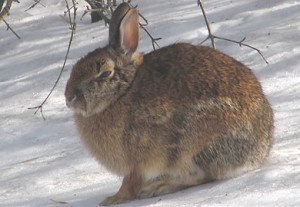 Late fall and winter bring “hard times” for small game species like bobwhite quail and rabbits, according to the S.C. Department of Natural Resources.
Late fall and winter bring “hard times” for small game species like bobwhite quail and rabbits, according to the S.C. Department of Natural Resources.
Natural food becomes scarce and resting and escape cover is thin in the fall and winter, according to Willie Simmons, Small Game Project Supervisor with the S.C. Department of Natural Resources (DNR). However, farmers and other landowners can do many things to help small game animals through this difficult period. Among the practices that can benefit small game species are leaving a small amount of unharvested crops along field edges, establishing weedy field borders or filter strips, allowing ditch banks and hedgerows to remain unmowed, and planting of supplemental wildlife food and cover strips.
For more information on providing wildlife habitat on your farm, contact the DNR Small Game Project in Columbia at (803) 734-3609.
When harvesting corn and soybeans, farmers should consider leaving several rows unharvested along the field borders. This provides an important food supplement throughout fall and winter when natural seeds have disappeared. After the harvest operation, the remaining stalks and stubble should be left in the field as long as possible. Crop residue provides valuable wildlife cover and protects fields from wind and water erosion. Some grain will be wasted on top of the ground, as even the sophisticated combines in use today can’t harvest every single grain. Control of most disease and insect problems can be achieved through crop rotation. If turning under the residue is necessary, leaving 10 percent around the field edges will provide food and cover where it is most beneficial to wildlife.
“The present-day practice of plowing and planting fields right up to the edge of the woods has drastically reduced the ability of the land to produce quail and rabbits,” Simmons said. Following corn or soybean harvest this fall is an ideal time to establish “field transition zones” or filter strips. A transition zone is simply a 25- to 30-foot wide area around the entire edge of a field that is allowed to grow up in native weeds, grasses and briars, and a filter strip is a band of vegetation established adjacent to a ditch, stream or other waterway to filter runoff while providing wildlife habitat. Allowing these areas to grow undisturbed for two to three years will provide critical nesting and brood-rearing habitat, as well as winter cover.
Field transition zones, also called habitat buffers, and filter strips are eligible for enrollment in the Conservation Reserve Program under a continuous signup period. The Conservation Reserve Program, administered by the county offices of the federal Farm Service Agency, provides incentive payments and annual rental payments for landowners willing to establish environmentally friendly practices on eligible croplands. The practice known as “CP-33: Habitat Buffers for Upland Birds ” was added in 2004 to the list of available practices under the Conservation Reserve Program. Eligible land may be enrolled at any time until a state’s allocation of buffer acres have all been enrolled.
“Practice CP-33 represents an outstanding opportunity for producers to retire marginally productive cropland on the perimeter of crop fields and dramatically improve small game habitat without sacrificing farm income,” said Simmons.
“After harvest time, when things slow down around the farm, the temptation is great to pull out the bush hog and clean up those brushy ditch banks and fence rows,” Simmons said. “Removal of these habitat components may increase planting area and give the farm a neater appearance, but small game populations will really suffer. Vegetation along ditches and fences serves as a windbreak, as well as supplying food, cover and travel corridors for quail and rabbits.”
Supplemental plantings, especially for small game use, can also be a beneficial practice. A small plot of annual grains or native legumes may help a covey of quail make it through a tough winter. Small patches of wheat and clover will offer some winter greenery for rabbits and quail and attract insects beneficial to quail chicks later in the spring, according to Simmons.

